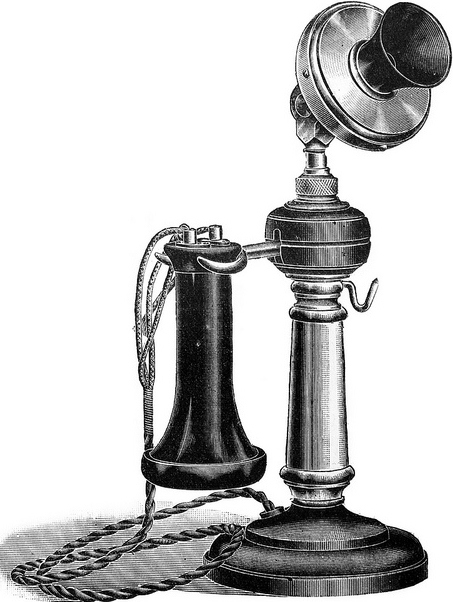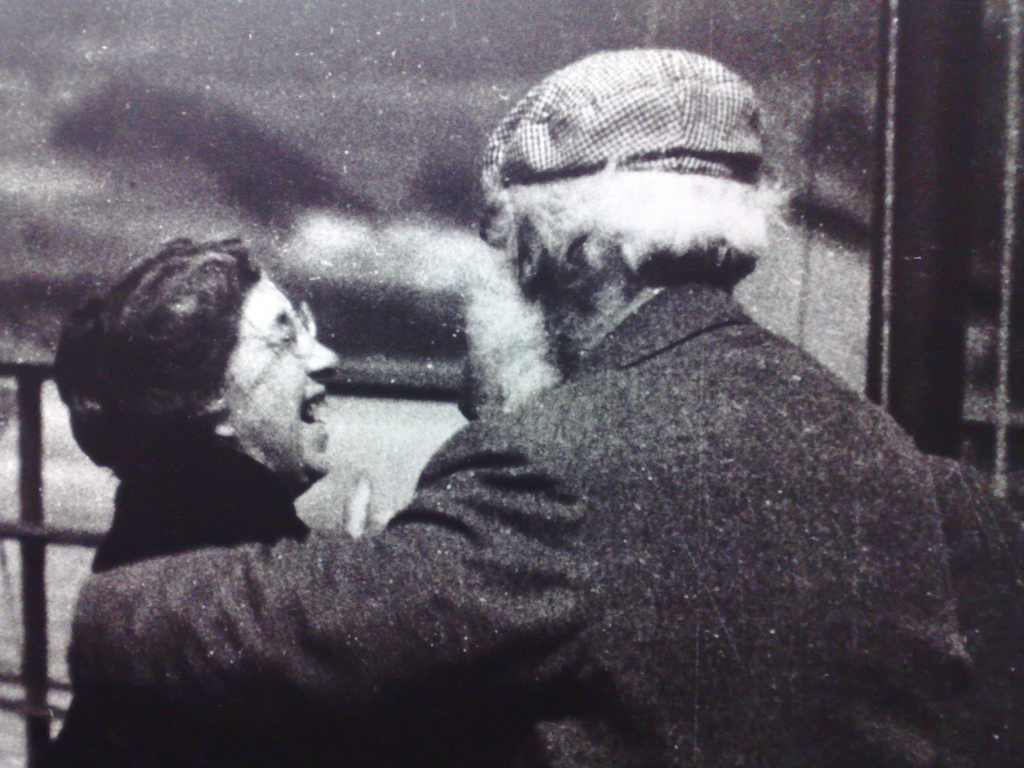 Some of the characters of Thomas McMahon’s novel, Loving Little Egypt:
Some of the characters of Thomas McMahon’s novel, Loving Little Egypt:
Mourly Vold, a nearly-blind, off-scale intelligent young man at the School for the Blind who figures out how to take a telephone’s receiver and transmitter, make an induction coil from a pencil, adapt a Ford’s magneto, turn a hairpin into a hookswitch, and make a rogue telephone which he connects to the 1920’s phone lines via a bullwhip wrapped in copper wire; and who leaves school to find an education and thereafter calls himself, after the cooch dancer, Little Egypt.
Various blind young people around the country who, helped by Little Egypt, create a sneaky, free party line through they can talk to each other, usually about sex.
 Alexander Graham Bell, who takes in Little Egypt and extends the boy’s education past James E. Parson’s Experiments in Electricity a Boy Can Do, but who himself can’t get through volume one of James Clerk Maxwell’s Treatise on Electricity and Magnetism. This nevertheless doesn’t stop him and Little Egypt from putting a steel needle on the barn roof and connecting it to two round accumulators, a coil, and a bell that rings when the atmosphere becomes electrically charged by storm clouds – thereby making a thunderstorm detector that is charming but as Bell’s wife, Mabel, points out, wholly unnecessary.
Alexander Graham Bell, who takes in Little Egypt and extends the boy’s education past James E. Parson’s Experiments in Electricity a Boy Can Do, but who himself can’t get through volume one of James Clerk Maxwell’s Treatise on Electricity and Magnetism. This nevertheless doesn’t stop him and Little Egypt from putting a steel needle on the barn roof and connecting it to two round accumulators, a coil, and a bell that rings when the atmosphere becomes electrically charged by storm clouds – thereby making a thunderstorm detector that is charming but as Bell’s wife, Mabel, points out, wholly unnecessary.
The telephone company, which installs a new and automatic system that doesn’t require human operators but that, unknown to it, has catastrophic weaknesses in its switching equipment, allowing Little Egypt to completely hijack the whole phone system. And when Little Egypt tells the phone company that if he can do it, so can someone with evil intent, they refuse to believe him, say it’s too expensive to fix anyway, and do nothing.
William Randolph Hearst, who hears about Little Egypt’s exploits, sells newspapers with stories about a so-called telephone vandal who is plotting to seize first the phone system and then the country for the Mexicans or maybe the Bolsheviks, one or the other.
Thomas A. Edison, whom Hearst asks to invent something to stop Little Egypt; and who might be a persistent and prolific inventor, but who for various reasons – including dirty tricks in re: the fight over direct current (his invention) and alternating current (Tesla’s invention), and a flippant refusal to pay Tesla royalties — is not a nice man.
Nicola Tesla, who is a flat-out genius inventor and to whom Mabel Bell sends Little Egypt for help, who alternates (little joke here) between being on the cover of Time magazine and being bug nuts; and who contrives with Little Egypt a scheme to make Hearst and Edison back off and moreover, kiss Tesla’s butt.
The rest of the plot:
So one night, Little Egypt coils copper wire around Hearst’s apartment building (the Claremont), and along with his blind cohort and Tesla meet Hearst and Edison there, and using a little box that is part of Tesla’s World System, trigger a resonance in the building, then drive the resonance to the point at which things start breaking and little lightning bolts shoot off the corners of metal objects, until Edison and Hearst sign a promise to pay for fixing the broken phone system, and yes, glory oh glory, they kiss Tesla’s butt.
All characters live happily ever after, more or less. Little Egypt went to the University of Illinois to study electrical engineering. Tesla’s alternating current became the foundation of today’s grid, and his gas-tube lamps were turned by glass blowers into neon lights by whose alien glow, many babies were conceived. The phone company saw the wisdom of long-range research and created a laboratory from which came radio astronomy, the transistor, the laser, and seven Nobel Prizes. Ultimately of course, except for Little Egypt who is fictional, everybody died, including Bell Labs, 1925 – 2008.
The book is intelligent, hard to put down, and hilarious — in spite of being, as much as anything, about the differences between engineers, scientists, and inventors. The author, Thomas McMahon, was both an aeronautical and a biomechanical engineer. Despite this immersion in science, he wrote a number of novels in which the varieties of technical intelligence are the main characters, and science is not just a decorative motif but moves plots. So he knew how to draw the line between fiction and fact: the author’s note in Loving Little Egypt, ends with, “It is never a good idea to believe a made-up story as if it were the truth.”
I suspect that on the whole, the book is more true than made-up, though it’s too multifarious to go through and separate one from the other. Tesla’s resonance-trigger may or may not be — my nerves are not strong enough for the Tesla literature — a combination of his World System and his Death Ray, both of which were not-entirely ridiculous inventions of his bug-nuts phase.
 I do happen to know the truth about two instances. One is that the blind kids commandeering the phone system were real and came to be called phone phreaks; McMahon had read a superbly-written story about them in a 1971 Esquire.
I do happen to know the truth about two instances. One is that the blind kids commandeering the phone system were real and came to be called phone phreaks; McMahon had read a superbly-written story about them in a 1971 Esquire.
The other is the time when — before the government commonly asked scientists for their advice, which the scientists thought the government generally ignored anyway — the Navy asked Edison for help with World War I:
◊ from Remarks As Delivered By The Honorable John H. Dalton, Secretary of the Navy: Realizing that such a catastrophe [as the sinking of the Luisitania] could easily be repeated, the Secretary of the Navy, Josephus Daniels. sought out Thomas Edison to help the Navy develop submarine countermeasures. . . . The resulting Naval Consulting Board did not produce the desired innovation and was for the most part considered a failure. Edison left the project and reported to the Secretary of the Navy his view on scientific-military innovation, “I made about forty-five inventions during the war, all perfectly good ones, and they pigeon holed every one of them. . . . Those fellows are a closed corporation.”
◊ from Thomas McMahon, Loving Little Egypt, Viking Penguin, 1987, p. 182: During the war, Secretary of the Navy Josephus Daniels had made Edison chairman of the Naval consulting Board. Edison announced that he would turn his entire laboratory over to war research. A great number of important ideas came to him. He worked on a shell which would release oleum in a cloud to ruin the enemy’s eyes and lungs. He conceived of a super-powerful underwater searchlight for melting holes in submarines. He tested a directional sea anchor which was supposed to allow ships to turn quickly to avoid torpedoes. In the course of his war service to the navy, he submitted over forty new developments for the use of the fleet, and not a one was accepted. His disappointment was enormous. He wrote to Secretary Daniels to say that, as far as he was concerned, the entire naval staff had shit for brains.
◊ And this codicil from Chemical & Engineering News, which I paraphrase: The Naval Research Lab, which had been proposed by Josephus Daniels and Thomas A. Edison, opened in 1923. At the lab’s entrance is a bust of Edison .
Also one irrepressible thought: this engineer writing fiction took facts and from them spun airy nothing. He didn’t, as recent nonfiction writers are famous for doing, take airy nothing and from it, spin facts. McMahon’s choice is pure pleasure, it makes a nice change, and if nonfiction writers are so entranced by the techniques and effects of fiction, why don’t they for chrissakes just write it?
________
Dalton’s remarks were delivered to The Current Strategy Forum, Naval War College, Newport RI, on 14 June, 1994. They were on the internet in 2009 but are not there any more; I had copied them at the time. The closest I can find is a reference to them here, scroll down to p. 9
Photo credits: phone – zigazou76
Mabel and Alexander Bell – taken by reinvented at the Alexander Graham Bell museum in Baddeck, Nova Scotia
Tesla’s lab in Colorado Springs – a double exposure with an odd history
bell labs is still around…it’s owned by Alcatel Lucent, but it is still there and functioning.
From that impeccable source, Wikipedia: As of July 2008, however, only four scientists remained in physics basic research. . . On August 28, 2008, Alcatel-Lucent announced it was pulling out of basic science, material physics, and semiconductor research, and it will instead focus on more immediately marketable areas, including networking, high-speed electronics, wireless networks, nanotechnology and software.
Actually the sources for all this are good. You’re perfectly right, it’s still there but its function changed enough that it’s not in danger of winning any more Nobel prizes.
Radiolab did a terrific show about phone phreaking earlier this year. http://www.radiolab.org/2012/feb/20/long-distance/ Well worth a listen. This book sounds really great too.
That’s so good, Christie! Thank you. I’ll add a link to the text too. Did I say thank you? Thank you.